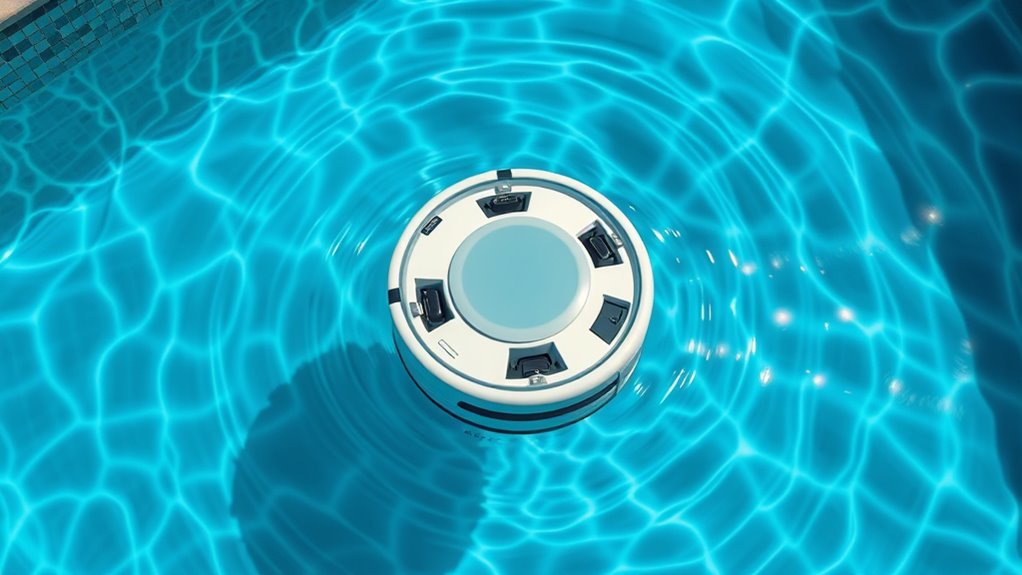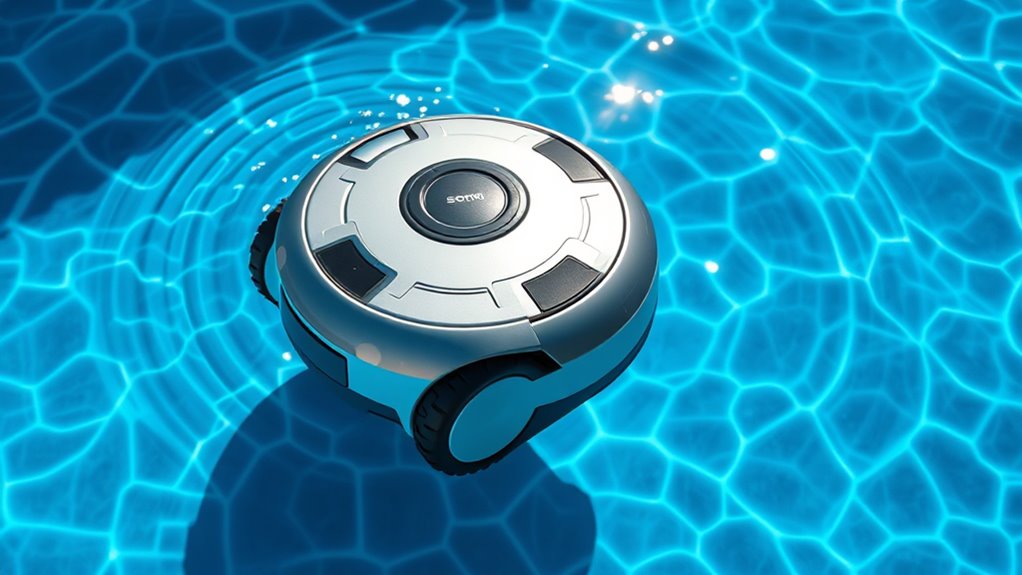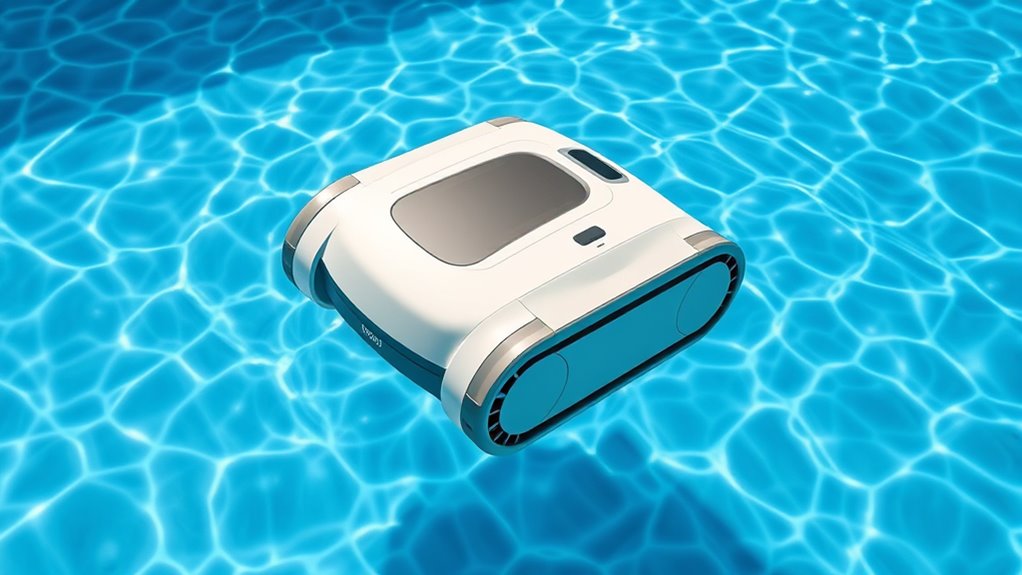Robotic pool cleaners use advanced sensors and navigation patterns like random and systematic routes to cover your entire pool efficiently. To optimize runtime, set the cleaning cycle based on debris levels, avoid obstacles, and keep sensors clean. Adjusting settings for your pool shape and regular maintenance help prevent getting stuck. For the best results, learn about customizing these features and troubleshooting common issues—they can make your cleaning more effective and save energy.
Key Takeaways
- Use boundary detection and obstacle sensors for thorough coverage and to prevent getting stuck or missing spots.
- Choose systematic patterns for geometric pools and random patterns for irregular shapes to optimize cleaning efficiency.
- Regularly calibrate sensors and clean debris to maintain accurate navigation and coverage.
- Adjust cleaning cycle duration based on pool size and dirt level to conserve energy and extend runtime.
- Program schedules and modes via app or manual controls to customize cleaning times and improve overall efficiency.
Understanding the Common Navigation Technologies in Robotic Pool Cleaners

Robotic pool cleaners rely on various navigation technologies to efficiently cover the entire pool surface. One common method is wall-following, where the cleaner detects and moves along the pool walls to ensure thorough cleaning of edges and corners. Some models use tilt sensors or accelerometers to help determine their position and avoid getting stuck. Others incorporate gyroscopes or compasses for better orientation, enabling the cleaner to follow specific paths. Infrared or ultrasonic sensors can detect obstacles, guiding the robot around furniture or pool features. Additionally, some cleaners utilize basic random movement algorithms, changing direction upon collision, while others use systematic patterns to methodically cover the surface. Navigation technology plays a crucial role in the efficiency and effectiveness of robotic pool cleaners, helping you choose a cleaner that matches your pool’s shape and your cleaning needs. Understanding the sensor systems used can also help in troubleshooting and optimizing the cleaning process. Moreover, advancements in navigation algorithms have led to increased precision in coverage, reducing cleaning time and improving overall performance. Incorporating smart mapping capabilities allows some models to create a virtual map of your pool, further enhancing cleaning accuracy and efficiency.
Random vs. Systematic Cleaning Patterns: What’s the Difference?

You’ll notice that some robotic pool cleaners use random patterns, while others follow systematic routes. Random cleaners may miss spots, especially in complex-shaped pools, affecting coverage efficiency. Systematic models typically cover every inch more thoroughly, making them better suited for irregular pool shapes. Additionally, understanding the resources and tools available can help you choose the most effective cleaning method for your needs. Incorporating navigation algorithms can significantly improve the coverage precision and efficiency of your robotic cleaner, ensuring optimal coverage. Employing mapping technology can further enhance the systematic approach by enabling the cleaner to adapt to different pool layouts dynamically. Properly leveraging smart features can also streamline maintenance and optimize cleaning schedules.
Coverage Efficiency Differences
Have you ever wondered why some robotic pool cleaners cover every inch efficiently while others miss spots? The difference often comes down to their cleaning patterns. Systematic cleaners follow a planned, methodical route, ensuring they methodically cover the entire pool surface. This approach maximizes coverage, reducing missed areas. In contrast, random pattern cleaners move unpredictably, which can lead to uneven coverage and missed spots, especially in larger pools. While random cleaners might be faster initially, they often require more runtime to achieve thorough cleaning. Systematic models, though sometimes slower at first, tend to be more efficient overall because they minimize overlaps and missed sections. Your choice depends on your pool size and cleaning expectations, but for consistent coverage, systematic cleaners generally perform better. Understanding the cleaning patterns helps in selecting the most effective robotic pool cleaner for your needs. Additionally, navigation algorithms play a significant role in how well a cleaner performs across different pool types.
Suitability for Pool Shapes
Choosing between random and systematic cleaning patterns depends heavily on your pool’s shape. If your pool is irregular or complex, a random pattern may cover more areas, ensuring no spot is missed. Conversely, a systematic pattern is ideal for straightforward, rectangular pools, providing thorough, predictable cleaning. Consider these factors:
| Pool Shape | Best Pattern | Coverage Style |
|---|---|---|
| Irregular | Random | Spontaneous, thorough |
| Rectangular | Systematic | Precise, organized |
| Freeform | Random | Flexible, adaptive |
| Geometric | Systematic | Consistent, reliable |
| Shaped pools | Combination | Balance of both |
Understanding your pool’s shape helps you choose the right pattern, maximizing efficiency and ensuring a cleaner, more inviting pool. Additionally, knowing navigation patterns can significantly impact the effectiveness of your cleaner, especially in complex shapes. Properly calibrated contrast ratios also contribute to better visibility of dirt and debris during cleaning sessions.
How Advanced Sensors Enhance Cleaning Efficiency

Advanced sensors play a crucial role in boosting the cleaning efficiency of robotic pool cleaners by enabling precise navigation and targeted debris removal. These sensors help your cleaner detect dirt, algae, and obstacles quickly, allowing it to adapt its path in real-time. Infrared and ultrasonic sensors map the pool’s layout, ensuring thorough coverage without unnecessary overlaps. Clarity sensors identify water clarity levels, prompting the cleaner to focus on dirtier areas. Some models use accelerometers and gyroscopes to maintain orientation, preventing missed spots. By accurately sensing surroundings, your robotic cleaner works smarter, not harder, reducing runtime and energy consumption. Enhanced data processing speeds, a key aspect of machine learning advancements, allow these sensors to interpret environmental data more effectively. This advanced sensing technology, including sensor calibration, ensures every inch of your pool gets cleaned effectively, saving you time and effort while keeping your pool sparkling clean. Additionally, integrating advanced sensor systems with smart algorithms can further optimize cleaning paths and adapt to changing pool conditions for even greater efficiency. Moreover, sensor integration can help these devices detect and respond to unexpected obstacles, further enhancing their performance and reliability.
The Role of Boundary Detection in Effective Pool Coverage

Boundary detection is essential for guaranteeing your robotic pool cleaner covers every area efficiently. It helps the robot identify edges like walls and steps, preventing missed spots or getting stuck. Accurate boundary detection ensures thorough cleaning, saving you time and energy. Many models use sensors or edge detection algorithms to navigate effectively.
| Boundary Type | Functionality |
|---|---|
| Wall sensors | Detect pool walls for proper navigation |
| Step sensors | Prevent falling off or getting stuck |
| Edge detection | Identify pool perimeter or obstacles |
| Limit sensors | Constrain robot to cleaning zones |
Programming and Manual Control Options for Optimized Performance

You can customize your robotic pool cleaner’s performance with flexible programming options that suit your pool’s layout. Manual control features give you direct access to guide the cleaner when needed, ensuring thorough coverage. Together, these options help you optimize cleaning efficiency and save you time and effort. Incorporating navigation patterns can further enhance cleaning effectiveness by adapting to various pool shapes and obstacles. Understanding family dynamics can also inform the best maintenance routines for your pool equipment, ensuring longevity and consistent performance. Additionally, operating hours information can help you plan cleaning sessions during times that minimize disruption and maximize convenience.
Programming Flexibility Options
To maximize a robotic pool cleaner’s efficiency, it’s essential to understand its programming flexibility options. Many models offer customizable cleaning schedules, allowing you to set specific days and times for operation. Some units let you choose between cleaning modes, such as spot cleaning, full pool coverage, or targeted areas, giving you control based on your pool’s needs. Additionally, adjustable cleaning cycles enable you to optimize runtime, conserving energy and extending the device’s lifespan. Advanced models may include app-based programming, enabling remote setup and real-time adjustments. These flexibility options confirm you can tailor the cleaning process to fit your pool’s size, shape, and your schedule, resulting in more effective cleaning with less manual intervention.
Manual Control Features
Manual control features give you direct access to your robotic pool cleaner’s functions, guaranteeing you can address specific cleaning needs quickly and effectively. With remote controls or smartphone apps, you can start, pause, or direct the cleaner to particular areas of your pool. This flexibility is especially useful for spot-cleaning stubborn dirt or adjusting the cleaner’s path around obstacles. Some models allow you to manually steer the device or set custom cleaning patterns, giving you precise control over its operation. Using these features can save time and energy, especially when routine programming isn’t enough. By leveraging manual controls, you can optimize cleaning performance, ensure thorough coverage, and respond swiftly to any issues that arise during the cleaning process. Additionally, communication security can be tested using Ethical hacking techniques to prevent unauthorized access. Understanding navigation patterns can also help you better plan manual interventions for optimal cleaning coverage, ensuring the safety features of your device are functioning properly.
Tips for Setting the Right Runtime for Your Pool Size

Choosing the right runtime for your robotic pool cleaner is essential to guarantee your pool stays clean without wasting energy or wear on the device. To do this effectively, consider your pool size and typical debris levels. Here are three tips:
Select the optimal runtime to keep your pool clean efficiently and prolong your cleaner’s lifespan.
- Start with the manufacturer’s recommended duration for your pool size as a baseline.
- Adjust the runtime based on debris accumulation, increasing if your pool gets dirty often.
- Monitor cleaning performance, and reduce runtime if the pool remains clean to save energy and extend the device’s lifespan.
Adjusting Cleaning Cycles Based on Pool Usage and Debris Levels

Adjusting your robotic pool cleaner’s cycles according to how often your pool is used and the debris it collects guarantees ideal cleaning efficiency. If your pool sees frequent use or accumulates more leaves and dirt, increase the runtime to ensure thorough cleaning. Conversely, if the pool is used less often, shorten the cycles to save energy and extend your cleaner’s lifespan. Keep an eye on debris levels—if you notice more debris in the skimmer or floating on the surface, run longer cleaning cycles. For light usage or minimal debris, shorter cycles work fine. Regularly assess your pool’s condition and modify the cycles accordingly, balancing cleanliness and efficiency while preventing unnecessary wear on your robotic cleaner. Additionally, choosing an advanced navigation pattern can help optimize cleaning coverage and reduce cycle times. Recognizing the importance of proper maintenance can further improve your cleaner’s performance and longevity.
Maintaining Your Robotic Cleaner for Consistent Navigation

To guarantee your robotic pool cleaner navigates your pool reliably, regular maintenance is essential. First, clean its brushes and filters weekly to prevent debris buildup that can hinder movement. Second, inspect the brushes and wheels for wear and replace them as needed to maintain ideal traction. Third, check the sensors and wheels for obstructions or dirt, ensuring they function correctly. Keeping these components in top condition helps your cleaner move smoothly and cover the entire pool efficiently. Additionally, regularly remove any stuck debris or tangled cords that might interfere with navigation. By staying proactive with these maintenance tasks, you’ll ensure your robotic cleaner performs consistently, saving you time and effort while keeping your pool perfectly clean.
Troubleshooting Navigation Issues and Improving Coverage

When your pool cleaner isn’t covering the whole area, start by checking for obstructions or debris blocking its path. You can also tweak the navigation settings to better suit your pool’s shape and layout. Finally, adjusting the coverage patterns helps guarantee every inch gets cleaned efficiently.
Detecting Obstructions and Debris
How can your robotic pool cleaner effectively detect obstructions and debris that might hinder its navigation? First, verify your cleaner’s sensors are clean and unobstructed, allowing accurate detection of obstacles. Second, pay attention to the device’s built-in obstacle detection system; most models use infrared or acoustic sensors to identify objects. Third, regularly inspect and remove debris from the cleaner’s brushes and filters to prevent false signals or missed obstructions. These steps help your cleaner adapt quickly to changing conditions, avoid getting stuck, and improve coverage. By maintaining sensor cleanliness, understanding your model’s detection capabilities, and keeping debris clear of critical parts, you’ll enhance its ability to navigate efficiently and keep your pool spotless.
Adjusting Navigation Settings
If your robotic pool cleaner isn’t covering the entire pool or seems to get stuck in certain areas, adjusting its navigation settings can often resolve the issue. Check if your device offers customizable modes, such as spiral, wall, or random patterns, and select the one that best suits your pool shape. Some models allow you to disable or enable features like obstacle sensors or boundary markers, which can help improve coverage. If your cleaner keeps getting stuck, try reducing sensitivity or adjusting the obstacle detection settings. Resetting the navigation system or recalibrating it can also help. Always consult your user manual for specific instructions related to your model. Properly tuning these settings ensures better coverage and fewer stuck spots, making your cleaning more efficient.
Optimizing Coverage Patterns
Optimizing coverage patterns is essential for guaranteeing your robotic pool cleaner thoroughly cleans every corner of your pool. To improve coverage, focus on these key steps:
- Adjust the cleaning cycle duration – longer cycles give your cleaner more time to cover all areas.
- Rearrange obstacles – remove or reposition objects that block the cleaner’s path.
- Use boundary markers or guide tracks – help the robot stay on course and avoid missing spots.
Regularly check for debris or tangled cords that can disrupt navigation. Make sure sensors are clean and unobstructed to enhance their accuracy. If coverage still feels incomplete, reset the cleaner’s programming or update its firmware. These simple adjustments ensure your robot efficiently navigates and cleans every part of your pool, saving you time and effort.
Maximizing Battery Life and Runtime Through Proper Settings

To extend the battery life and runtime of your robotic pool cleaner, you need to adjust its settings thoughtfully. Start by selecting shorter cleaning cycles during less dirty times and disabling unnecessary features like scrubbing or high-power modes. Properly setting the cleaner’s schedule helps conserve power and extends runtime. Additionally, ensure the bin is emptied regularly to prevent strain on the motor. To maximize efficiency, consider these settings:
| Setting | Recommended Adjustment | Benefit |
|---|---|---|
| Cleaning Cycle | Shorter, more frequent cycles | Saves battery, maintains cleanliness |
| Power Mode | Use eco or low-power mode | Extends runtime |
| Schedule | Off-peak hours or manual runs | Prevents overuse |
Adjusting these parameters helps your cleaner perform at its best without draining the battery prematurely.
Frequently Asked Questions
How Do Robotic Pool Cleaners Handle Obstacles Like Ladders or Skimmers?
When you ask how robotic pool cleaners handle obstacles like ladders or skimmers, you’re wondering if they can navigate around or over them. Most models are equipped with sensors that detect obstacles, prompting the cleaner to change direction or avoid them altogether. Advanced robots might even climb or maneuver around certain obstacles, ensuring thorough cleaning without getting stuck. You’ll find that choosing a model with good obstacle detection improves your pool cleaning experience.
Can Robotic Pool Cleaners Operate Effectively in Both Small and Large Pools?
You might wonder if robotic pool cleaners work well in both small and large pools. The good news is, they’re designed to adapt to different sizes, automatically adjusting their cleaning patterns. In small pools, they finish quickly, while in larger pools, they cover more ground efficiently with multiple cleaning modes. Just make certain you select the right model for your pool’s size, and you’ll enjoy a spotless pool regardless of its dimensions.
Are There Specific Maintenance Routines to Improve Navigation Accuracy?
Think of your robotic pool cleaner as a diligent explorer. To boost its navigation accuracy, you should regularly clean its sensors and brushes, ensuring no dirt or debris cloud its view. Keep the wheels and tracks free of obstructions, and update its firmware if possible. Consistent maintenance acts like a compass, guiding your cleaner smoothly around your pool, making every cleaning session more effective and efficient.
Do Different Pool Shapes Affect the Cleaning Pattern or Coverage?
Different pool shapes definitely impact how your robotic cleaner navigates and covers the area. Irregular or freeform pools might require more manual intervention or longer cleaning times because the robot may struggle to reach all corners. Regularly monitor its pattern and adjust settings if possible. To improve coverage, consider dividing larger or complex pools into sections, so your cleaner can systematically handle each area more effectively.
How Do Environmental Factors Like Sunlight or Wind Impact Navigation Performance?
Environmental factors like sunlight and wind can considerably impact your robotic pool cleaner’s navigation. Bright sunlight might cause glare, making sensors less effective, while wind can blow debris into the pool, requiring more cleaning cycles. You should position your cleaner to avoid direct sunlight on sensors and remove loose debris before it starts. Adjust your cleaning schedule to account for windy days, ensuring thorough coverage and ideal performance.
Conclusion
Mastering your robotic pool cleaner’s navigation transforms your pool cleaning into a seamless, almost magical experience. With the right patterns, sensors, and maintenance, you’ll turn hours of scrubbing into minutes of effortless perfection. Imagine a cleaner so smart and efficient, it seems to have a mind of its own, leaving your pool spotless every time. Get these tips right, and you’ll wonder how you ever managed without this high-tech marvel doing all the hard work for you!









